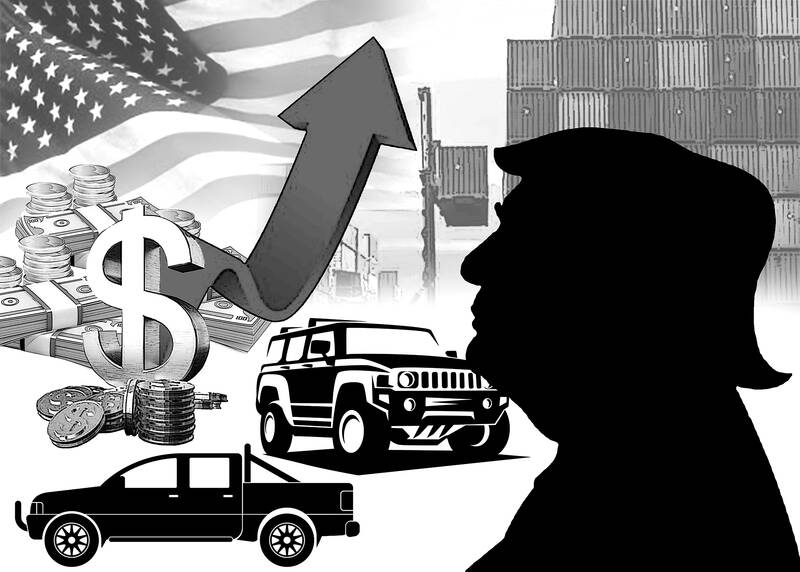US president-elect Donald Trump’s plan to slap a 25 percent tax on all imports from Mexico and Canada could strike the bottom lines of US carmakers, especially General Motors (GM), and raise prices of SUVs and pickup trucks for US consumers.
GM leads the carmakers that export cars from Mexico to North America. The top 10 car manufacturers with Mexican plants collectively built 1.4 million vehicles over the first six months of this year, with 90 percent heading across the border to US buyers, a Mexican auto trade association said.
Other Detroit manufacturers would likely also feel the pain: Ford and Stellantis are the top US producers in Mexico after GM, whose shares fell on Tuesday, the day after Trump’s tariff announcement.

Illustration: Constance Chou
GM is expected to import more than 750,000 vehicles from Canada or Mexico this year, with most manufactured south of the border, according to business analytics firm GlobalData.
They include some of GM’s most popular vehicles, including about 370,000 Chevy Silverado or GMC Sierra full-sized pickups and about 390,000 midsized SUVs. GM’s Mexican plants also build two of its critical new electric vehicles, battery-powered versions of its Equinox and Blazer SUVs. Those GM models and others are already in the crosshairs of another expected Trump policy: ending a US$7,500 electric vehicle (EV) subsidy, a move first reported by Reuters.
GM, Stellantis and Ford declined to comment on Trump’s proposed tariffs.
Kenneth Smith Ramos, Mexico’s former chief negotiator for the US-Mexico-Canada Agreement (USMCA), said the move could hurt the US as much as its North American trading partners.
“The US would be shooting itself in the foot,” he said.
The impact on Mexico’s vehicle industry would also be “very negative.”
GM employs 125,000 people in North America; a decline in sales of its Mexico-made cars could hurt its profit for the entire region, potentially putting pressure on payrolls on both sides of the border.
The tariff hikes would also serve as a reminder of the supply chains, which closely bind the three members of the USMCA. Mexico and Canada account for more than 50 percent of all auto parts exported to the US — sending about US$100 billion in parts. Imposing the tariffs would increase the costs of all vehicles assembled in the US.
The vast impact of Trump’s threatened tariffs on Mexico and Canada raises questions about what the incoming administration is trying to accomplish economically and the potential collateral damage to US companies and consumers.
Trump billed the action as a punishment for the unrelated problems of immigration and the trafficking of the drug fentanyl, posting on social media that the tariffs would remain in place until Mexico and Canada halt what he called an “invasion” of “Illegal Aliens.”
The reference to drugs and migration have led some analysts to predict the tariffs are more of a negotiating tactic than a genuine policy proposal.
“Given the [social media] post makes an explicit reference to the flow of people and drugs across the southern and northern borders, it suggests this specific tariff threat is more of a negotiating tool than a revenue raiser,” said Thomas Ryan, North America economist at Capital Economics.
“It leaves the door open to Canada and Mexico coming up with a credible plan over the next two months to try and avoid those tariffs,” he added.
Mexican President Claudia Sheinbaum called for a dialogue with Trump and said the proposed tariff’s lacked “sense” and would worsen inflation and kill jobs in both countries.
She also raised the specter of retaliation, although given its vast flow of exports to the US, Mexico’s economy remains more vulnerable to tariff threats.
Trump’s import taxes could also theoretically stop Chinese carmakers from using Mexico as a way around steep US tariffs on Chinese EVs, but those imports are already effectively blocked by other US trade barriers.
Shares of GM were down 8.2 percent late on Tuesday afternoon, while Stellantis fell 5.5 percent and Ford shares were down 2.6 percent.
Free trade with the US, first in the form of North American Free Trade Agreement (NAFTA) and then as USMCA, transformed Mexico’s nascent automotive industry into the country’s most important manufacturing sector and the poster child of its export prowess.
However, 30 years after NAFTA’s establishment, Trump has put that all on the line.
In the hyper-competitive world of car and truck production, a 25 percent tariff could kneecap a Mexican industry that has spent years tightly integrating itself with the US, the destination of about 80 percent of all Mexican-made vehicles.
Higher tariffs would also hit US consumers. While the company that imports goods into the US directly pays the tariff, that cost is inevitably passed on to the consumer via higher prices.
“That’s how tariffs work. Even though the [Trump] administration might want to spin it that Mexico is paying ... ultimately the consumer will bear this,” said Sudeep Suman, a managing partner with consultancy AlixPartners.
That could hit many pickup trucks popular in rural parts of the US that overwhelmingly voted for Trump. Notably, the Toyota Tacoma, Ford Maverick, Stellantis’ Ram, and GM’s Chevrolet Silverado and GMC Sierra are all made in Mexico.
GM might be able to absorb some costs from its highly profitable pickup trucks, but other manufacturers selling lower-cost vehicles like the Nissan Sentra could find it difficult to continue building profitable models, AutoForecast Solutions industry analyst Sam Fiorani said.
“Somebody is going to have to eat that cost and that is going to the manufacturer or customer,” Fiorani said. “All vehicles sold in the United States would be more expensive or considerably less profitable.”
Tariffs could also hit the cost of vehicle production in the US, because so many parts now come from Mexico. The Latin American nation represents 43 percent of all US auto-part imports, larger than any other country.
Regional cooperation across North America brings down costs for customers, said Francisco Gonzales, head of the Mexican National Industry of Autoparts.
Carmakers “cannot be producing everything in a single country,” he said. “Because it makes it uncompetitive.”
Concerns that the US might abandon Taiwan are often overstated. While US President Donald Trump’s handling of Ukraine raised unease in Taiwan, it is crucial to recognize that Taiwan is not Ukraine. Under Trump, the US views Ukraine largely as a European problem, whereas the Indo-Pacific region remains its primary geopolitical focus. Taipei holds immense strategic value for Washington and is unlikely to be treated as a bargaining chip in US-China relations. Trump’s vision of “making America great again” would be directly undermined by any move to abandon Taiwan. Despite the rhetoric of “America First,” the Trump administration understands the necessity of
In an article published on this page on Tuesday, Kaohsiung-based journalist Julien Oeuillet wrote that “legions of people worldwide would care if a disaster occurred in South Korea or Japan, but the same people would not bat an eyelid if Taiwan disappeared.” That is quite a statement. We are constantly reading about the importance of Taiwan Semiconductor Manufacturing Co (TSMC), hailed in Taiwan as the nation’s “silicon shield” protecting it from hostile foreign forces such as the Chinese Communist Party (CCP), and so crucial to the global supply chain for semiconductors that its loss would cost the global economy US$1

US President Donald Trump’s challenge to domestic American economic-political priorities, and abroad to the global balance of power, are not a threat to the security of Taiwan. Trump’s success can go far to contain the real threat — the Chinese Communist Party’s (CCP) surge to hegemony — while offering expanded defensive opportunities for Taiwan. In a stunning affirmation of the CCP policy of “forceful reunification,” an obscene euphemism for the invasion of Taiwan and the destruction of its democracy, on March 13, 2024, the People’s Liberation Army’s (PLA) used Chinese social media platforms to show the first-time linkage of three new
Sasha B. Chhabra’s column (“Michelle Yeoh should no longer be welcome,” March 26, page 8) lamented an Instagram post by renowned actress Michelle Yeoh (楊紫瓊) about her recent visit to “Taipei, China.” It is Chhabra’s opinion that, in response to parroting Beijing’s propaganda about the status of Taiwan, Yeoh should be banned from entering this nation and her films cut off from funding by government-backed agencies, as well as disqualified from competing in the Golden Horse Awards. She and other celebrities, he wrote, must be made to understand “that there are consequences for their actions if they become political pawns of